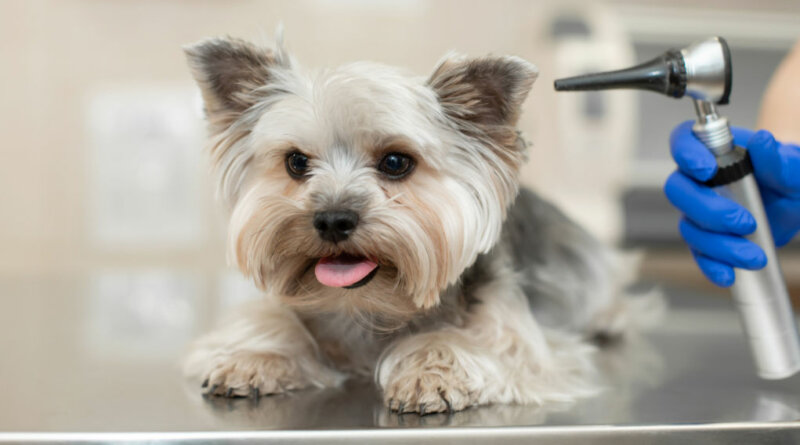How to Tell if Your Dog is Deaf
Dog deafness is a common issue that affects dogs of all ages and breeds.
While some dogs are born deaf, some may acquire it over time for multiple reasons.
This can impact the quality of life of your pet. They may become irritable and anxious and resort to unusual behavior, such as excessive barking, as a coping mechanism.
Diagnosis is essential for effective treatment. So, identifying the symptoms and causes of dog deafness may enable you to begin targeted training earlier.
Here, we have compiled a list of symptoms and causes to help you understand your pet’s condition better.
We will also discuss at-home and at-home laboratory tests that may assist in getting a more accurate diagnosis.
So, without further ado, let’s get started!
Deaf Dog Symptoms: Common Signs of Dog Hearing Loss
Hearing loss in dogs can be congenital or acquired.
Either way, it can be detectable through keen observation of their behavior in everyday life.
Here we have compiled a list of some common symptoms that may indicate your pet’s hearing loss.
1. Lack of Response to Sounds
If your dog no longer responds to sounds as it used to, it could be a sign of hearing loss.
These could be everyday noises, such as you calling its name, rattling its toys, etc.
We recommend repeating the activities louder to see if they respond. This will allow you to determine the exact range still audible to your pet.
2. Excessive Barking
Dogs with hearing loss may bark more than those with good hearing. This can be for multiple reasons.
These include frustration and confusion regarding their sudden inability to hear things they could listen to previously.
It could also be that they can’t hear their voice and are unaware of how loud they’re being.
3. Sleeping Through Noises
Has there been an incident lately that alarmed everyone but your dog? This could potentially be a sign of hearing loss.
For example, there might have been an emergency that shook everyone awake while your dog slept through it.
Alternatively, it could even be something simpler such as loud footsteps or the bell ringing.
4. Unusual Behavior
Hearing loss may make your dog irritable and anxious.
This may manifest as certain weird and unusual behaviors your pet might not have had before. For example, your dog may become unnecessarily startled.
The truth is, they’re just feeling vulnerable and are coping with their sudden loss of hearing in their own way.
5. Difficulty Following Commands
If your dog is no longer responding to familiar commands and training, it might be a sign that they can’t hear them.
Dogs with hearing loss have to be trained differently as per their needs.
For example, you might ditch the clicker and switch to a symbol to reinforce positive behavior.
It is important to remember that your dog’s behavior could also be traceable to other underlying medical concerns.
It is best to consult a veterinarian so they can make an accurate diagnosis and prescribe a suitable course of action if required.
RELATED: Deaf Dog Training: Everything You Need to Know
Dog Hearing Loss Causes
Dog hearing loss can be traceable to numerous factors.
Having a greater understanding of the underlying reason may allow you to choose the most suitable strategy to deal with it.
1. Age-related
Dogs may lose their optimum hearing ability as they age.
This is because the sensory cells in the cochlea of the inner ear may become damaged over time.
This classifies as neural hearing loss, and it is usually permanent.
2. Genetics
Certain traits and disabilities may be transmitted to the offspring through genetics.
So, dogs with a history of deaf parents or relatives may be susceptible to congenital deafness.
3. Ear infections
Did you know debris accumulated in the vertical ear canal can cause hearing loss?
Whether this is temporary or permanent may depend on its condition and severity.
A professional may put it under a microscope to detect the bacteria involved and prescribe the appropriate treatment if required.
4. Trauma
Physical trauma may trigger hearing loss by damaging the neurological pathways that enable proper hearing.
These may include a head injury or exposure to loud and consistent noises.
5. Cognitive Disorders
Cognitive disorders such as dementia or cognitive dysfunction syndrome (CDS) may affect your pet’s hearing ability.
It may reduce your dog’s ability to hear, interpret, react to, or remember various sounds.
It is important to remember that these are merely hypothetical scenarios that may explain your dog’s hearing loss.
We recommend consulting a veterinary professional for an accurate diagnosis and treatment.
What Dog Breeds Are Prone to Deafness?
Deafness can occur in any breed. But, the genetic makeup of certain dog breeds may predispose them to hear loss. These include:
Deafness is common in these breeds but not guaranteed. Heredity and good nutrition play an essential role in overall health, including hearing capability.
We recommend understanding the health implications of any breed before adopting it.
Informed decisions based on prior knowledge will allow you to get a dog compatible with your lifestyle.
Getting a deaf dog can be a rewarding experience for anyone with the time to train and manage them properly.
But it may not be the best decision for anyone with neither the schedule nor the temper to get to know these loveable canine friends.
How Can I Test My Dog’s Hearing at Home?
Did you know that animals’ hearing declines as they get older?
Yes, much like humans, aging also affects our adorable canine friends. This can be hard to navigate if you don’t know how to handle it.
Here, we’ll address the issue of testing your dog’s hearing at home. You may watch for indicators to test your pet’s auditory capability.
We recommend going through the checklist below and recording your responses as necessary.
Checklist & Questions To Ask
Has your pet stopped responding to its name as it used to?
They may seem inattentive and continue doing whatever activity they’re engaged in. This may be because they can’t hear your voice.
Try saying their name in a louder voice in a more audible pitch to see if they react in their usual adorable way.
Does your dog no longer come rushing to the food bowl or when you rattle the box of their favorite healthy dog treats?
Again, it may be a sign that it simply cannot hear the sound. Try doing it near them to see if they notice this time.
But only do it once because sudden noises or vibrations may startle deaf dogs and scare them.
What is your dog’s usual behavior as you return from work?
Did your dog come rushing to the door as it heard the rattling of keys in the doorknob?
Has that expression of excitement and enthusiasm diminished lately? This may be a sign that your dog is gradually moving towards deafness.
It is worth noting that these are merely small everyday examples from daily life.
While they may denote dog deafness in adult dogs, they could also be traceable to another more serious medical condition.
It is best to consult a veterinarian if you also observe other symptoms such as lethargy, fear, anxiety, etc. This may assist in getting an accurate diagnosis.
You may also ask them about your pet’s management or any special treatment based on their breed and individual needs.
RELATED: 6 Top Deaf Dog Myths (Debunked)
Is There a Dog Hearing Test?
Yes, there are hearing tests that can be used to measure your pet’s level of hearing ability and deafness.
You may have to get an appointment at your local pet clinic, as these are mainly performed by veterinarians. These include:
Brainstem Auditory Evoked Response (BAER) Test
Electrodes are placed over the dog’s head to measure its brain responses to various sounds and noises. These mainly involve (but are not limited to) clicking sounds.
The electrodes record the responses evoked by the dog. This data is then used to measure if the dog has normal hearing or is suffering from any auditory defects.
The BAER test is a reliable and objective method of testing a dog’s hearing faculty. It can even test the deafness range, that is, if it is unilateral or bilateral.
This can assist breeders or owners in taking the appropriate measures and training the dog properly.
But it is worth noting that it only accounts for the noises in a normal human range.
The test may sometimes present distorted results since the hearing range for humans and dogs is different.
For example, some dogs may be classified as ‘deaf,’ but they may still be able to hear high-pitched noises beyond the human ear.
What is the Ideal Time for a BAER Test?
Hearing pathways for dogs aren’t developed until the puppy is 5-6 weeks of age. The test is qualitative.
It requires that the ear canals be open. So the best time to do it is during that age range.
Puppies go from being highly active, playful, and energetic to relatively calmer and sleepy as they get to their 5-week birthday.
This makes it a suitable time since it will be easier to manage.
We recommend not performing the test when your little pup is younger than five weeks. But you can do it whenever you want after that.
There is no time frame for adult dogs. There are no complications and rules since their ears have reached maturity.
Why Take the BAER Test?
Taking the BAER Test for dogs may be advantageous for owners and breeders. This is because:
- It is the only test that offers 100% reliable results
- It displays if the dog is unilaterally or bilaterally affected (that means deafness in one or both ears)
- Is it easy and only takes about 10-15 minutes for each dog
Breeders: How They Check Deaf Dog Symptoms
Understanding the potential hearing ability of a puppy before birth can help breeders avoid congenital deafness (deafness by birth).
Now, how can they do that here? By testing the auditory faculty of the dog before qualifying them for breeding.
Hereditary hearing loss may pose a crucial problem in a dog’s life.
They may get anxious and irritable and exhibit behavioral problems. This may be a difficult situation for the owner and the dog.
Sometimes, they’re euthanized because of psychological problems and the lack of training resources to deal with them.
So breeders can determine which dogs have good hearing and only breed those specific breeds.
The dominant hearing genes may increase the likelihood of good hearing by a significant margin.
Owners: What You Need to Know About Deaf Dog Symptoms
Deaf dogs can pose a threat to themselves as well as their owners. They may get into unnecessary danger since they won’t hear it from afar.
This includes not being able to detect dangerous vehicles or animal predators.
This necessitates targeted training to teach them as per their needs to ensure their survival.
Veterinarians recommend incorporating special measures in your disciplining style.
Knowing that your dog is bilaterally or unilaterally deaf may enable you to mold your strategies accordingly.
An early diagnosis can help you develop the appropriate training techniques. Adjusting to new changes will be more convenient for a puppy than a dog.
Deaf Dog Symptoms: Conclusion
Dog deafness is a complex issue and may impact your pet’s quality of life.
Some cases are traceable to congenital deafness, while some dogs acquire it due to multiple factors. These may range from aging, infections, trauma, etc.
As a pet parent, it is your responsibility to identify the signs of deafness in your pet and take them to a veterinarian as required.
Deaf dogs have specialized training and management that may differ from other dogs their age.
They need to be positively reinforced through hand signals since they cannot hear your voice.
We recommend taking a BAER Test to ensure a correct diagnosis.
It is reliable and will inform you if the deafness is partial or whole, enabling you to create strategies suited to your pet’s unique needs.
This will allow you and your canine companion to live a fulfilling life.
READ NEXT: The Complete Guide to Owning a Deaf Dog








